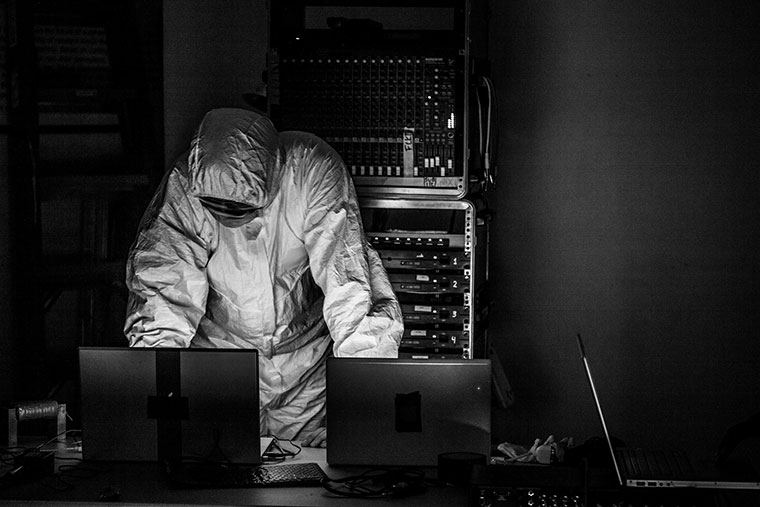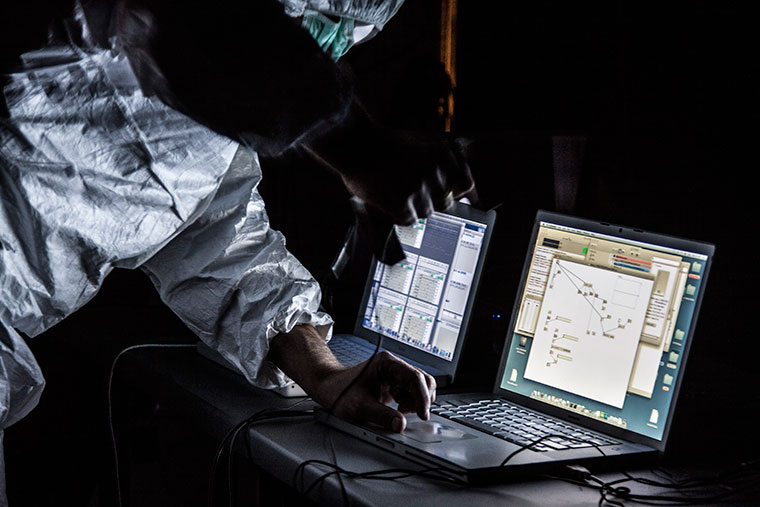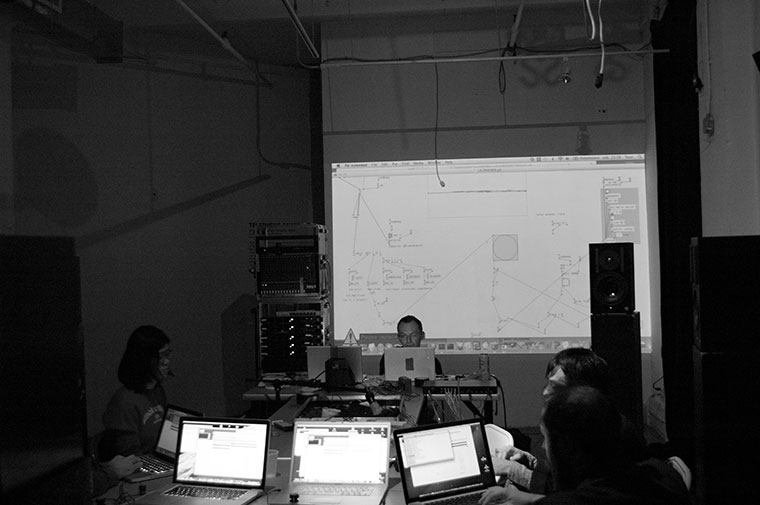| |
|
|
| |
DECIPHERING RANDOMNESSThe project poses fundamental questions concerning the working of human brain and randomness. Creativity and the search for original solutions, creative coding, building of new compositions, performances and prototypes, requires the extension of intellectual tools, including the replacement of simple generative techniques with probabilistic methods as well as with methods related with randomness. In order to deeply understand, develop and overcome algorithmic methods (including programs and devices), one needs to understand the notion of randomness and random generators. The work analyses, among others, different probabilistic methods and pseudo-random generators, which are indispensable in numerous artistic applications as well as in other domains (music, performance, computer games, safety on the network). These methods should be developed and applied through building new prototypical devices and programs. The project discusses new creative techniques and artistic strategies: creation of prototypes, open source, open hardware, hacking, tactical media etc. It is intended for experienced users interested in practical use of randomness for creative purposes in music, performance and visual arts. The workshop consists of: Randomness also plays an essential role in artistic practice
(concept of the ready made, metalanguage in conceptual art, new
formal ways of composing through the use of probability
distributions and stochastic techniques, Xenakis's GENDY and
UPIC systems, noise etc.) 1. The concept of RandomnessRandomness appears in many subject domains (mathematics,
physics, biology, computer science, art, economy etc). However
they encapsulate different, sometimes antinomic meanings.
2. Pseudo-random number generatorsThe use of pseudo-random number generators: discussion and
practical application of pseudo-random generators for
constructing visual works, music compositions and films with the
use of languages such as LISP, Supercollider, Pure Data, Fluxus,
Ianix etc. 3. Extraction of randomness from a physical processesThe Workshop investigates hidden physical processes occurring
permanently in our everyday environment saturated by
electromagnetic waves and radiation as possible sources of
randomness by practical examining of: Workshops of sound and visual techniques, which consist in
detection of invisible phenomena and testing of the properties
of physical objects through detection, amplification, sonic and
visual analysis. This practical workshop and series of
experimental situations are meant to equip the artist with DIY
skills from the range of techniques such as detection,
modulation and creation of random sequences and fields for audio
and video output. The project consists in extraction of randomness from a
physical processes by detection and transformation through the
use of hardware tools like electromagnetic coils, detectors,
sensors [light, flex etc], EEG electrodas, amplifiers,
modulators, analyzers and more specialized devices for detecting
radiation(Geiger, scintillation, gas and semiconductor
counters). Generating random numbers is not easy. People are extremely bad at generating random sequences. People behave in a mechanic and repetitive manner. Human brain aims to conceive reality within periodic sequences and patterns. This is why most sequences and rhythms we encounter in art and music are repetitive. The existing computing machines don't generate totally random sequences; the so called pseudo-generators of random numbers are periodic. This is way I decided to use radioactive materials. Quantum mechanics is believed to be fundamentally non-deterministic and it shows that randomness operates on certain level of our reality.
4. The significance of randomness for socio-political processesInternet, after delusions concerning openness and
decentralization, is being understood more in terms of control
exercised by government agencies (e.g. NSA) and advertising
agencies. We live in a new era, in which mathematics has become
a powerful weapon. Random numbers are crucial for cryptography:
for encryption keys, random authentication, key-agreement
schemes, generating prime numbers and so on. Breaking of the
random-number generator means breaking the entire security
system. Understanding of the use of random numbers plays a very
important role in times of mass surveillance, e.g.: NSA
manipulates us by installing secret "backdoor" in encryption
systems, which should protect our data. It concerns
cryptographic standards, which are based on mathematical objects
called "elliptic curves". It turns out, that there are certain
elliptic curves, which appear to be random, but are in fact easy
to decipher. It enables the agency to break into our emails and
personal data. The governments and intelligence agencies exploit
our ignorance, and manipulate us more when we are less aware of
mathematics. 5. Randomness and philosophyRandomness and the problem of the possibility of free choice and will in human brain. Mind Uploading Problem 6. For ParticipantsWe encourage participants to bring a device emitting
electromagnetic waves or some form of recording (digital sound
recorder or tape, camera, headphones, computer with PD installed
or Supercollider, etc)
7. About InstructorRobert B. LISEK is an artist and mathematician who focuses on systems and processes (computational, biological, social). He is involved in the number of projects focused on radical art strategies, hacktivism and tactical media. Drawing upon conceptual art, software art and meta-media, his work intentionally defies categorization. Lisek is a pioneer of art based on AI and bioinformatics. Lisek is also a composer of contemporary music, author of many projects and scores on the intersection of spectral, stochastic, concret music, musica futurista and noise. He also explores the relationship between bio-molecular technology, code and issues arising from network technologies by combining his DNA code with codes of viruses and recently by testing influence of radioactive materials on biological entities. Lisek is also a scientist who conducts a research in the area of theory of partially ordered sets in relation with artificial general intelligence and complexity theory. Author of many exhibitions and concerts, among others: NUCLEAR RANDOM GENERATOR - Harvestworks Arts Center New York, Fluc Wanne Vienna, RADICAL MIND - Columbia University New York, TERROR ENGINES - WORM Center Rotterdam, Secure Insecurity - ISEA Istanbul; DEMONS - Venice Biennale (accompanying events); Manifesto vs. Manifesto - Ujazdowski Castel of Contemporary Art, Warsaw; NGRU - FILE, Sao Paulo; NEST - ARCO Art Fair, Madrid; Float - DMAC Harvestworks and Lower Manhattan Cultural Council, NYC; WWAI - Siggraph, Los Angeles; Falsecodes - Red Gate Gallery, Beijing; Gengine - National Gallery, Warsaw; Flextex - Byzantine Museum, Athens, FXT- ACA Media Festival, Tokyo and ISEA, Nagoya. more: www.lisek.art.pl/ Authordevelopment: Robert B. Lisek |
|
| |
produced by Robert B. Lisek & Fundamental Research Lab
|
|





